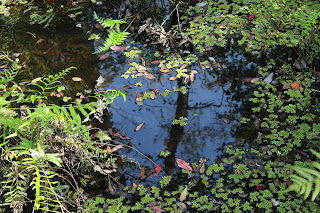.....and fidgeting, and bouncing, and walking in the park, and getting one's head up in the clouds.....
Remember how a nun's ruler would rap your knuckles if she caught you doodling?
I have news for the good Sister. According to recent studies "doodling has been shown to increase attention in monotonous tasks and to improve recall." So, what was with all the knuckle rapping?
And surely you remember fidgeting in church and getting "the look" from your mother? Now it comes to light that "fidgeting is theorized to modulate focus!" I hope my dear departed mother knows this now and is repenting.
Our creativity workshop on Saturday afternoon touched on the effect of movement on creativity.
Turns out that fidgeting and doodling entertain the part of our brain that is starting to get bored so that, with the rest of it, we can pay better attention to the task at hand. And, right off the bat, I can hear the OC's voice demanding to see the "data."
I don't have any. I have half-formed, fuzzy ideas. Scientific American is not begging for permission to publish my findings (though, come to think of it, wouldn't that be nice!) Off he goes, no longer interested. He's partial to hard facts verified in a lab setting. Anything less and
he starts to fidget and grow restless.
But back to the doodling and the fidgeting. It doesn't take a Department of Education study, at great cost to the taxpayer, to figure out that people need to move. Especially little people. I was horrified to hear, a few years ago, that some schools were doing away with recess. Someone high up in an administrative ivory tower had obviously lost his mind. Any woman with children could tell you, for free, what an insane idea that was.
Even the nuns knew we had to move.They circled the playground like Border Collies, nipping at the heels of those inclined to clump together for chatting purposes. "Run, girls! Play ball! Jump rope! Play tag.....
Move!" They knew our brains would balk at declining Latin verbs, or wrestling with Algebra, if we didn't energetically oxygenate our blood during that brief ten minutes on the playground. Anything to increase the flow to the grey matter. But they seemed to have a blind spot when it came to doodling and fidgeting. Neither, in their books, rated as exercise.

I make no claims to be a scientist. I'm merely reporting random tidbits, bandied about by a bunch of women at the library, some of whom were fidgeting as they spoke. And nobody rapped their knuckles. All the tidbits related to how movement encourages productivity and creativity. One woman told of taking part in an experiment where, in a set amount of time, participants had to connect two lines on a sheet of paper. She only managed to draw nine connecting lines in the given time. All participants were then asked to stand up and jump around for a few minutes. They then repeated the exercise and everyone drew a significantly higher number of lines after the physical activity. Ergo, as the OC cowers in dismay, whatever about creativity, the activity certainly increased production.
One study done in the UK in 2005 concluded that "kids who are allowed to fidget during class learn more quickly than those who are not." One of our group told of autistic children being allowed to bounce up and down in their seats as they worked because experiments had shown that, when allowed to do so, they would learn more and get better scores.
Interestingly, the effects on the teachers of classrooms full of bouncing, fidgeting children were not reported.
Curious, I turned to Google and read the introduction to a paper on this very subject. Thinking I had hit the mother lode, I scrolled down to the meat of the article only to have the writer switch from the English of the introduction to her native Swedish, leaving me up the garden path without a shovel. But from the introduction I had at least gleaned that she believed we fidget the better to focus, relax, explore new ideas and to delay the onset of boredom.
Those are some ideas I could raise a glass to.
Another paper set out to compare highly creative children with those diagnosed as having ADHD. The implication seemed to be that it is sometimes easier, and more convenient, to label an energetic, creative child as hyper active and to medicate him, than to actually provide the level of stimulation that such a child needs.

I'd done nothing more active all day than boil the kettle for tea and drive to the library. The hyperactive child who lives and bounces around in my head had been lacking inspiration lately so, based on what I had so recently heard, I stopped at the park on my way home from the library. It was busy --- parents pushing toddlers on the swings, hordes of teenagers playing basketball, tennis balls pinging back and forth and kids kicking balls around the soccer fields. I set off at a trot on the walking path....Well, as close to a trot as my aging knees will allow. The sky overhead was blue. Red leaves shone among the green along a fence, cheeky squirrels squatted in my path, palm trees stood silhouetted against turquoise and peach as the sun started sinking, the scrubby oaks arched over my head and my mental cobwebs got swept away, at least for a while. And here you have the result --- full of the usual half-formed ideas, woefully lacking in hard data.....and not one call yet from Scientific American.
I probably need my knuckles rapped.




















































